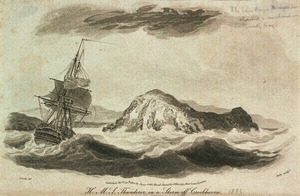HMS Thunderer (1783) facts for kids

The plan of Thunderer
|
|
Quick facts for kids History |
|
|---|---|
| Name | HMS Thunderer |
| Ordered | 23 July 1781 |
| Builder | John & William Wells, Rotherhithe |
| Laid down | March 1782 |
| Launched | 13 November 1783 |
| Commissioned | January 1793 |
| Fate | Broken up, March 1814 |
| Notes | |
| General characteristics | |
| Class and type | Culloden-class ship of the line |
| Tons burthen | 1,679 (bm) |
| Length | 170 ft 8 in (52.02 m) (gundeck) |
| Beam | 47 ft 7 in (14.50 m) |
| Depth of hold | 19 ft 11 in (6.07 m) |
| Propulsion | Sails |
| Sail plan | Full-rigged ship |
| Complement | about 600 |
| Armament |
|
HMS Thunderer was a powerful warship, called a ship of the line, built for the Royal Navy in 1783. She was armed with 74 cannons, which made her a "third-rate" ship. During her time at sea, she fought in many important naval battles. These included the Glorious First of June, the Battle of Cape Finisterre, and the famous Battle of Trafalgar.
Contents
The Story of HMS Thunderer
Building and First Missions
The ship Thunderer was built by the Wells brothers in Rotherhithe, England. She was launched into the water on November 13, 1783. After being built, the ship was kept in storage until 1792. Then, she had some repairs to get her ready for service in 1793.
Battles in the West Indies
In 1794, Thunderer fought in a big battle called the Glorious First of June. Her captain was Albemarle Bertie. From 1796 to 1801, the ship served in the West Indies. During this time, under Captain Pierre Flasse, Thunderer fought in the Battle of Jean-Rabel. In this battle, Thunderer and another British ship, HMS Valiant, made a French ship called Harmonie sink itself. This stopped the British from capturing it.
On October 15, several British ships were chasing two French warships and a smaller ship called Éveillé. The British ships had to stop chasing the larger French ships because they were too close to shore. However, Thunderer and Pomone joined the chase. They were able to capture Éveillé, which had 18 guns and 100 men. This French group had been at sea for 60 days and had captured 12 British merchant ships. The British had already gotten two of these back.
In 1799, Thunderer was part of a British group that stopped a schooner named Pegasus. This ship was flying an American flag and carrying 68 enslaved people from Jamaica to Havana. The British sent Pegasus to the Bahamas, where the enslaved people were sold. This happened in late June and early July. Advertisements for the sales said the enslaved people were from Martinique. This suggested that Pegasus might have been using fake documents.
On October 10, 1800, Thunderer rescued the crew of HMS Diligence. Diligence had hit a reef off the coast of Cuba. The British set Diligence on fire as they left. It turned out she had hit an uncharted sandbar near Rio Puercos.

HMS Thunderer in a storm off Crookhaven in 1803
|
New Captain and More Captures
Thunderer was put back into service in 1803. Her new commander was Captain William Bedford.
On June 14, 1803, Thunderer captured a ship called Rosamond. Rosamond was sailing from San Domingue to France. She was carrying coffee, cotton, and sugar, worth about £30,000.
On July 26, 1803, Thunderer captured a French privateer ship called Venus. Venus was a brig with 18 cannons and a crew of 150 men. She had sailed from Bordeaux five days earlier with four other privateer ships. Captain Bedford said Venus was new and well-suited for the Royal Navy.
In 1805, Thunderer fought in Admiral Calder's fleet at the Battle of Cape Finisterre. Her captain, William Lechmere, went back to England to be a witness at a court-martial. This was about the events of Admiral Calder's actions during the battle.
Later that year, Thunderer fought in the famous Battle of Trafalgar. She was commanded by her First Lieutenant, John Stockham. The ship's surgeon was a Scotsman named James Marr Brydone. He was the first person from the main British fleet to spot the French and Spanish ships. Thunderer signaled the Victory, and soon after, battle orders were sent to the British fleet. This started the Battle of Trafalgar.
On November 25, Thunderer stopped a ship called Nemesis. Nemesis was sailing from Isle de France to Leghorn, Italy. She was carrying spices, indigo dye, and other goods. Thunderer shared the money from this capture with ten other British warships.
Final Years
In 1807, Thunderer served in the Dardanelles Operation. She was part of a group of ships led by Admiral Sir John Duckworth. Thunderer was badly damaged when the ships left the area. However, she went with Admiral Duckworth on the Alexandria expedition of 1807. In May, she left Alexandria for Malta, where she was repaired for 30 days.
Thunderer was taken out of service in November 1808. She was broken up for parts in March 1814.
It is believed that some of her wood was used to build Christ Church, Totland on the Isle of Wight. Other parts were used to build the lych gate at St. Nicolas' Church in North Stoneham, near Eastleigh.

